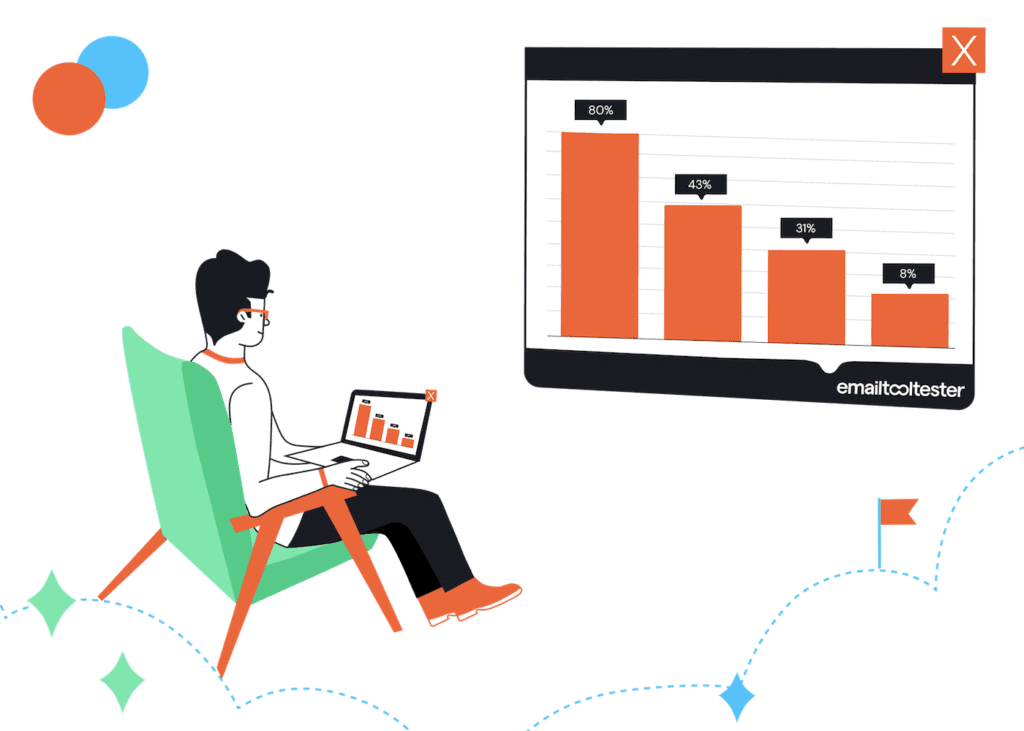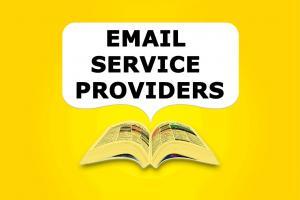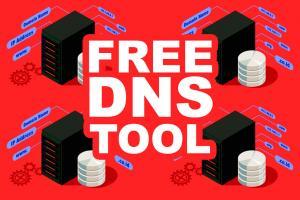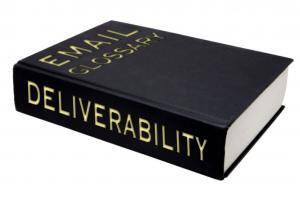EmailToolTester
DMARC records are TXT records in a domain’s DNS that help protect email senders and recipients from spam, phishing, and email spoofing. A DMARC record allows a sender to indicate that their emails are protected by SPF and/or DKIM, and tells a receiving mail system what to do if neither of those authentication methods passes: Nothing Quarantine the message Reject it. Below are 5 examples of DMARC records, with an explanation of what each configuration means. At the end of the article, I also provide a quick guide on how to create and install a DMARC record yourself. DMARC Record Example 1: For Monitoring Only v=DMARC1; p=none; rua=mailto:dmarc-reports@example.com; v=DMARC1: This indicates the version of DMARC used. This part is mandatory and specifies that this is a DMARC record. p=none: The policy applied to email that fails the DMARC check. In this case, “none” means the domain is not enforcing DMARC
Since 2017, we’ve been analyzing email deliverability rates across various platforms. These bi-annual tests provide marketers with valuable insight into the performance of the top email service providers. AWeber was one of the first tools we included on our list. Founded in 1998, AWeber is one of the industry’s oldest players. Currently, it caters to over 100,000 users, which means it continues to be a popular tool for small businesses. The tool boasts interesting email marketing features, but the key question remains: do the emails reach their intended inboxes? Let’s look at AWeber’s email deliverability rate over the years. But First, What is Email Deliverability (and How is It Calculated)? Email deliverability measures whether an email message reaches the recipient’s inbox, rather than falling into the black hole of spam and missing emails. When conducting our tests, we measure the percentage of emails successfully delivered to recipients’ inboxes, including both
Emails. We all get them, but what makes us want to click on some more than others? With billions of emails zipping around daily, standing out is no small feat. Even the most enthusiastic subscribers can quickly lose interest if your emails consistently fail to hit the mark. But boosting your email game isn’t just about crafting the perfect message; it’s also understanding the people behind those opens and clicks. In this article, I’ll take you through the most effective tactics for boosting your email engagement, with some great visual examples to get you inspired. If you’re looking to ramp up those numbers and learn how to increase email engagement, you’ve landed in the right spot! 7 Tactics to Increase Email Engagement 1. Craft Compelling Email Subject Lines to Boost Open Rates Your email subject line is your first (and maybe your last) impression on users. Average email users receive
The use of email has grown rapidly over the last few decades, with an email address being an essential tool in both our personal and professional lives. But just how much has the use of email changed, and how are most of us using emails on a day-to-day basis? Has social media eaten into what used to be time spent on emails in recent years? The number of email users worldwide is expected to continue growing at a rate of 3% each year according to technology market research firm, Radicati, suggesting that emails are here to stay when it comes to business and personal communications. We’ve gathered some of the most interesting statistics about email usage today and how our use of emails has changed over time, alongside insights from our own studies. Key statistics There are 4.48 billion email users worldwide in 2024, meaning 56.8% of the total world
Constant Contact has gained itself a pretty good reputation in the email marketing world thanks to its niche feature set and nearly 30 years’ experience in the industry. When choosing a new email service provider, it’s completely normal to focus on the price of the software, especially if you have a tight marketing budget. However, email deliverability is also an extremely important factor to consider and should be a top priority if you are looking to get the very best results out of your email marketing efforts. Now, let’s take a look at what email deliverability is, Constant Contact’s deliverability features, their results from our tests, and lastly, how they compare to other popular providers. What is Email Deliverability? Ever wondered why some emails land straight in your inbox and others disappear into promotions or spam folders? Well, it’s all down to email deliverability, which is a crucial topic for
Email deliverability is essential for the success of any email marketing campaign, determining whether emails reach the intended recipients’ inboxes or are flagged as spam. While there are a number of factors that influence email deliverability, the choice of Email Service Provider ( ESP ) is one that shouldn’t be overlooked. Factors such as sender reputation, infrastructure, and compliance practices all play crucial roles in getting emails delivered to inboxes. Initially marketed as a budget-friendly alternative to Mailchimp, MailerLite has become one of the most popular ESPs on the market in recent years. But, how do MailerLite’s deliverability rates compare to other email marketing services? To help answer this question, we’ll be diving into the results of our bi-annual deliverability tests, which we’ve been running since 2017. Read on to learn about how MailerLite has performed, and how it stacks up against its competitors when it comes to email deliverability.
Ever wondered why some emails get delivered to your inbox, and others end up in the spam folder, or even vanish? Well, email deliverability is why. And, it’s not just about sending great emails. But, also the deliverability rate of your email service provider (ESP) tool. While following best practices has the greatest impact on email deliverability, we’ve found that your choice of ESP can also influence whether your emails will be delivered inbox or land in spam. So, ensuring your email gets to your subscribers’ inboxes requires a combination of implementing non-spammy practices, and choosing an ESP with solid deliverability rates. In this article, we’ll discuss the email deliverability rate of ActiveCampaign. You’ll gain insights from our latest deliverability test results and also learn best practices for maintaining an excellent deliverability rate. Let’s get started! What is Email Deliverability? If you think email deliverability means your emails get delivered
As an email marketer, implementing a DMARC (Domain-based Message Authentication, Reporting, and Conformance) record could be very beneficial for your email marketing campaigns. DMARC is a protocol that uses SPF (Sender Policy Framework) and DKIM (DomainKeys Identified Mail) to determine the authenticity of an email message (check out our DMARC vs DKIM vs SPF article for more information on the relationship between the 3 standards). While not essential, there are several reasons why a DMARC record is a wise choice for email marketers. Advantages of having a DMARC record Enhances Email Deliverability: DMARC helps in ensuring that your emails are authenticated against SPF and DKIM standards. This authentication process increases the likelihood of your emails being delivered to the recipient’s inbox rather than being marked as spam or getting blocked by email providers. Protects Brand Reputation: By preventing unauthorized parties from sending emails that appear to come from your domain
DMARC, DKIM, and SPF are all email authentication methods used by senders to combat email spoofing and phishing attacks. While you could use SPF and DKIM independently, you can’t use DMARC without also using at least one of the other methods. And the truth is: if you’re an email marketer, that’s sending emails to hundreds or thousands of people, you need to implement all three methods together to achieve respectable levels of authentication and deliverability. That’s because each method works differently, with its own strengths and weaknesses, and it’s only when they are implemented together that you will achieve comprehensive protection. Let’s look at each one in turn and compare them… SPF (Sender Policy Framework) SPF is an email authentication protocol that verifies the sender’s IP address. It allows domain owners to specify which mail servers are authorized to send emails on behalf of their domain. How SPF Authentication works
Email marketing is a vital tool to engage with your audience effectively. And although a lot of thought is put into which is the right provider for you, one thing that is often overlooked is the email deliverability rate of your chosen email marketing provider. This topic is becoming increasingly important, especially due to recent changes with key providers such as Gmail and Yahoo. To help you get your head around email deliverability and its importance, we will provide you with a clear understanding of what makes a good email deliverability rate and the key factors that affect this, taking a close look at Mailchimp’s deliverability. All of the information provided in this article are key takeaways from our bi-annual email deliverability tests. The Importance of Email Deliverability Email deliverability has a significant influence on whether your emails reach recipients’ inboxes or whether they get lost along the way, ending















